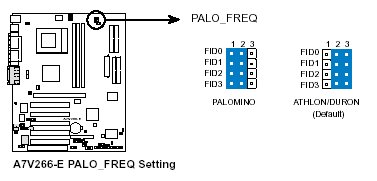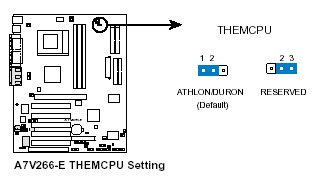last change: 14.1.2003
since 16.9.2000

Why the heck is there a tank ?!?
Main Page
"HowTo" Guides
Troubleshooting Guides
BIOS related information
CPU related information
Overclocking
Articles
Downloads
Forum
Contact
Links
|
What ASUS Mainboards support Barton
CPUs?
|
|||||||||||||||||||||
|
The ASUS CPU Support pages tell this:
*Only with a FSB333 sticker on south bridge. |
|
What is the fastest CPU that I can
use in an A7V Classic (KT133 Chipset, 100Mhz FSB / FSB200)
|
|
As this has been asked often: The fastest CPUs that can be used in an A7V "classic" are the Athlon Mod. B (100Mhz FSB) 1.3Ghz and 1.4Ghz. Also the newest Durons up to 1.3Ghz. See the footnote "FID info" on settings for 1.3Ghz and 1.4Ghz Athlon Mod.B. Use one of the newer BIOSes. (e.g 1008 or newer) There's a new website under construction which will list actual CPU compatibility and incompatibility reports from A7V users: www.conram.com |
|
Will a AthlonXP run in a A7V / A7V133
/A7V266 etc. that does not officially support it?
|
|
The AthlonXP might work on non-AthlonXP compatible A7V series Mainboards, too - even on the old A7V KT133. The newer A7V BIOSes, for example, include code to support the AthlonXP and Duron 1Ghz and up. But noone will guarantee that it will work - so don't count on it. You might get almost any AthlonXP to boot, but that does not mean it will run stably and reliably. I read that AMD told people that the AthlonXP will only run reliably with 133Mhz FSB - so unlocking it and running at 100Mhz FSB with higher multiplier might get you into trouble. In my opinion this compatibility or incompatibility comes from the fact that between Athlon and AthlonXP the specification for the processor bus has been changed. As far as I know for AthlonXP so called "L-C-L" Filters are needed, which are NOT implemented on older mainboards. Without these filters it depends on how the production tolerances of CPU, Chipset, Mainboard etc. affect each other. Either it does simply not boot, it works unstably, or it works perfectly. Noone can tell you if your combination will work - even if others have had success with a certain combination, it might or might not work for you. So only try using AthlonXPs on mainboards that are 100% fit for the purpose (see tables and links below). If you want to try on a not officially compatible board, than be prepared to run into trouble. Especially on the A7V the biggest drawback is it's low FSB of 100Mhz, while AthlonXPs are designed fior 133Mhz. So the resulting speed at a given multiplier is lower than it should be. Overclocking the FSB is a very bad idea in my opinion, because on one hand the A7V doesn't overclock well, on the other hand FSB overclocking overclocks everything - from RAM to IDE. Only do so if you regard the data on your PC as expendable. |
|
What about Multipliers above 12.5
with Athlon CPUs (NOT AthlonXP) ?
|
|
The multiplier does NOT depend on the
mainboard, it does depend on the CPU. |
|
Which Mainboards do support AthlonXP?
Which do support Duron 1Ghz and up?
Which support "Thoroughbred"? |
||||||||||||||||||||||||||||||||||||||||||||||||||||||||||||||||||||||||||||||||||||||||||||||||||||||||
|
Here is the most recent List by ASUS: Official, General ASUS CPU Support list
AthlonXP (Thoroughbred) Ready Mainboards
*To find out your mainboard revision, have a look between the PCI slots. There is a printing with the name of your Mainboard, next to it is the revision number. Note that there might be a dot after the number - it is important! "1.05" is not the same as "1.05.", the latter is newer. **A7V266
and A7V266-E: set Jumper"PALO_FREQ" to the Palomino Jumper-Settings: Leave the THEM_CPU Jumper at "Athlon/Duron" ! Theoretically THEMCPU = 2-3
makes the A7V266 use the on-die thermal diode - but this does not
work!
For all other supported
Mainboards leave all Jumpers on factory default (Jumperless): Make sure your Power Supply is sufficiently dimensioned. It should be able to provide at least 300W! |
||||||||||||||||||||||||||||||||||||||||||||||||||||||||||||||||||||||||||||||||||||||||||||||||||||||||
|
What CPU may I use in my Mainboard?
|
|||||||||||||||||||||||||||||||||||||||||||||||||||||||||||||||||||||||||||||||||||||||||||||||||||||||||||||||||||||||||||||||||||||||||||||||||||||||||||||||||||||||||||||||||||||||||||||||||||||||||||||||||||||||||||||||||||||||||||||||||||||||||||||||||||||||||||||||||||||||||||||||||||||||||||||||||||||||||||||||||||||||||||||||||||||||||||||||||||||||||||||||||||||||||||||||||||||||||||||||||||||
|
This is translated from ASUS Germany: Question: I want to upgrade my A7V series Mainboard with a new CPU, which ones may I use? Answer: See the following table. BEFORE upgrading get the latest final BIOS, especially with older boards it might be better to get the latest BETA BIOS. For AthlonXP also see the table on top of this page!
All data as of 4.5.2002 *To find out your mainboard revision, have a look between the PCI slots. There is a printing with the name of your Mainboard, next to it is the revision number. Note that there might be a dot after the number - it is important! "1.05" is not the same as "1.05.", the latter is newer.
|
|||||||||||||||||||||||||||||||||||||||||||||||||||||||||||||||||||||||||||||||||||||||||||||||||||||||||||||||||||||||||||||||||||||||||||||||||||||||||||||||||||||||||||||||||||||||||||||||||||||||||||||||||||||||||||||||||||||||||||||||||||||||||||||||||||||||||||||||||||||||||||||||||||||||||||||||||||||||||||||||||||||||||||||||||||||||||||||||||||||||||||||||||||||||||||||||||||||||||||||||||||||

